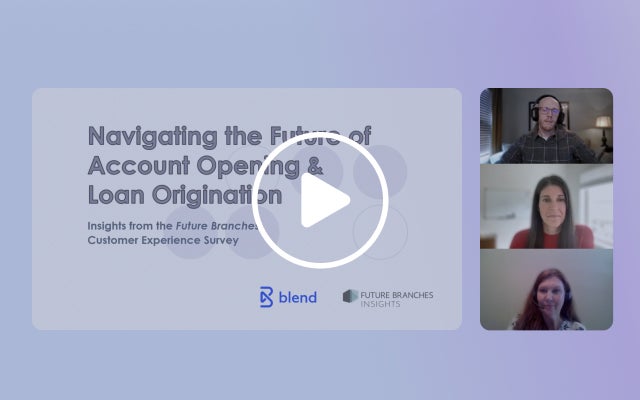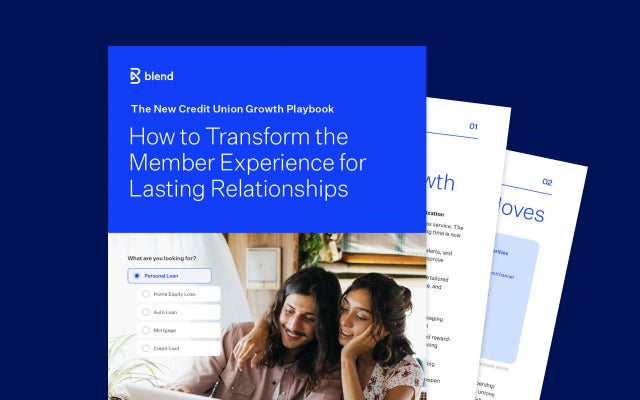May 5, 2023 in Composable origination
The what, why, and how of Composable Origination
How a modular approach to origination can revolutionize your business.

So, what exactly is Composable Origination?
Composable Origination is a new approach to lending that fundamentally changes the way banking products are processed and delivered.
This approach is based on the idea that lenders can break down the origination process into smaller, modular components that can be assembled and customized to create an origination process that fits the specific needs of individual lenders and borrowers.
Why do I need it?
While the majority of banks and credit unions offer consumers a way to open a checking account or get a loan online, it’s often still a cumbersome and time-consuming process. Even if you’re a current customer you’ll likely find yourself navigating frustrating paper-based processes, manual steps, and prompts that ask you to pick the phone or come into a branch. And after all that, it can still take days or weeks to get approved.
For the lender this includes application processing, underwriting, documentation, and funding. These tasks often require significant manual effort and are prone to errors and delays, which can be frustrating for both lenders and borrowers.
It’s not that financial institutions aren’t technically savvy or lack the vision to serve their customers a modern origination and onboarding experience. They’re burdened by their existing infrastructure. Legacy systems can be difficult to integrate with newer digital platforms, leading to a disjointed experience for borrowers.
It’s not that financial institutions aren’t technically savvy or lack the vision to serve their customers a modern origination and onboarding experience. They’re burdened by their existing infrastructure.
Additionally, origination often involves multiple departments within a bank, each with its own set of workflows and processes. Digitizing these workflows can be difficult because it requires coordination and cooperation across departments.
This makes it all the more challenging to offer consumers the personalized, proactive and simple experiences they’ve come to expect. Meanwhile digital-first banks and tech entrants without these challenges can offer a loan or deposit account in just a few taps.
Unfortunately today’s out-of-the box origination solutions don’t fundamentally solve these challenges. They act more like a digitized paper application with little room for customization or integration with the latest technology.
However, with Composable Origination, lenders have the flexibility to build a streamlined, custom process that leverages the latest technologies and industry best practices.
Composable Origination unlocks lenders’ ability to deliver financial products like a tech company.
How does it work?
At its core, Composable Origination is about breaking down the loan origination process into a set of modular components that can be assembled and reconfigured as needed. These components can include things like data validation tools, credit decision engines, document management systems, and more.
At Blend, we enable Composable Origination on the Blend Builder Platform. The Platform includes the modular components, APIs, orchestration layer, and data tools necessary to deliver custom origination experiences at scale.
What are the benefits?
1. Increased flexibility
By breaking down applications into smaller, independent components, Composable Origination enables developers to modify, replace, or add new features to an application without disrupting the entire system. Additionally, it enables lenders to move away from monolithic, one-size-fits-all loan origination systems. This approach also allows lenders to experiment with new tools and technologies without disrupting their existing systems
2. Increased customization for lenders and customers
With a composable process, lenders can customize the origination experience to meet their specific needs. For example, they might choose to incorporate a third-party data provider to verify borrower information, or they might use a machine learning-based credit decision engine to automate the underwriting process. They can also easily incorporate the latest and greatest technology features specific to their customers’ unique needs.
3. Scalability
Composable Origination enables FI’s to scale their applications by adding or removing components as needed, without affecting the rest of the system. This means that businesses can easily adjust to changing traffic levels and user demands without sacrificing performance or reliability.
4. Reusability
Composable Origination promotes the reuse of existing components across different applications, reducing the need for developers to build new functionality from scratch. This not only speeds up development time, but also ensures that applications are built with a high degree of consistency and reliability.
5. Agility
With Composable Origination, businesses can more easily experiment with new features and functionality, as well as quickly iterate on existing ones. Additionally, Composable Origination can be more adaptable to changing market conditions and regulatory requirements. As lenders face new challenges and opportunities, they can quickly modify and update their loan origination process to stay ahead of the curve.
6. Lower costs
Another benefit of Composable Origination is that it can help lenders to reduce costs and increase efficiency. By leveraging pre-built components and services, lenders can avoid the time and expense of building everything from scratch. They can also automate many of the manual steps in the loan origination process, freeing up staff to focus on higher-value activities.
As lenders face new challenges and opportunities, they can quickly modify and update their loan origination process to stay ahead of the curve.
In summary
Composable Origination represents a new frontier in banking technology. It enables financial institutions to flexibly build and scale applications that can adapt to changing market conditions and customer needs. With Composable Origination, lenders can finally transform their origination process and provide a better experience for borrowers.

Curious to learn more about Blend’s Composable Origination solution?
Find out what we're up to!
Subscribe to get Blend news, customer stories, events, and industry insights.


